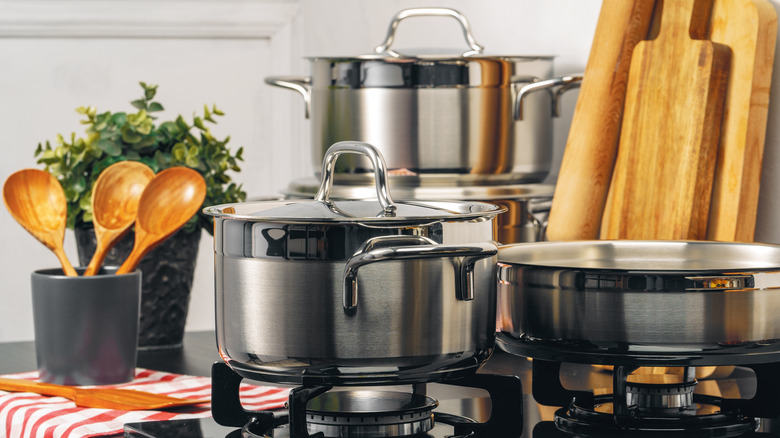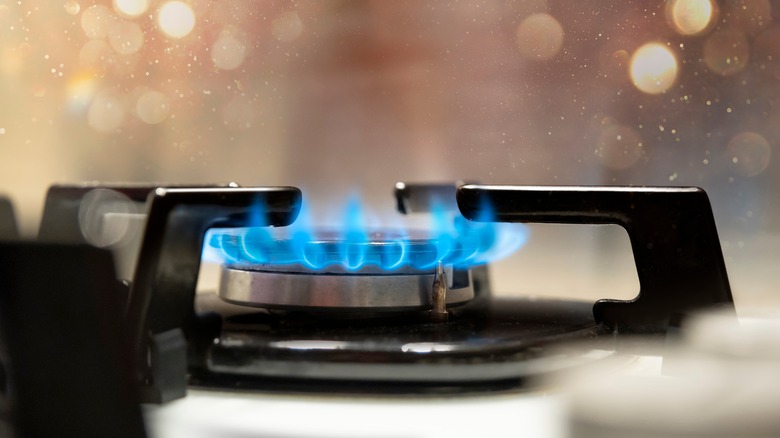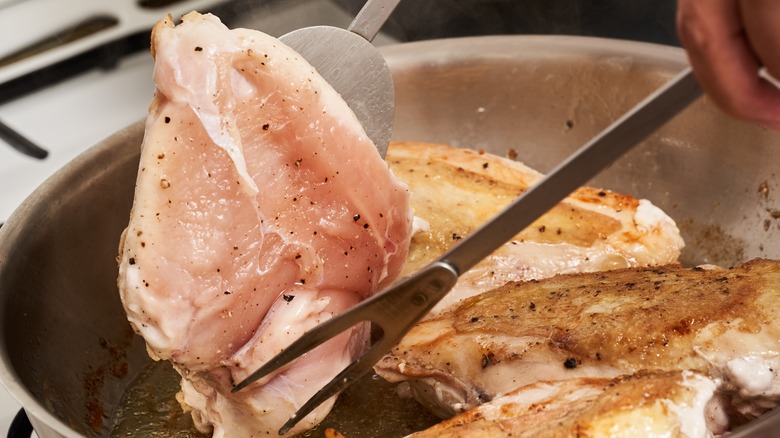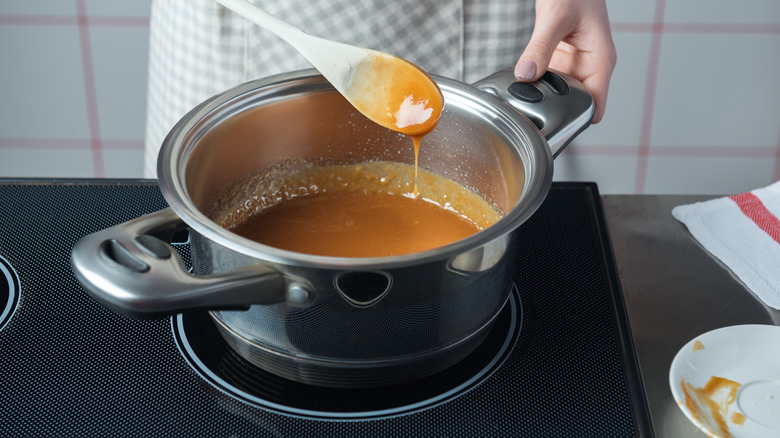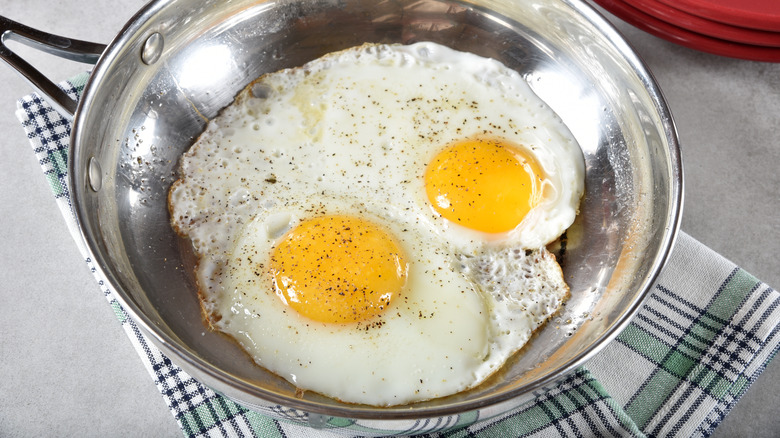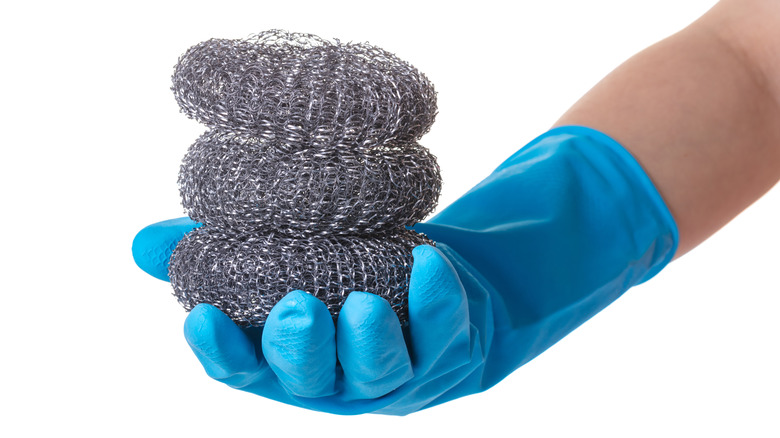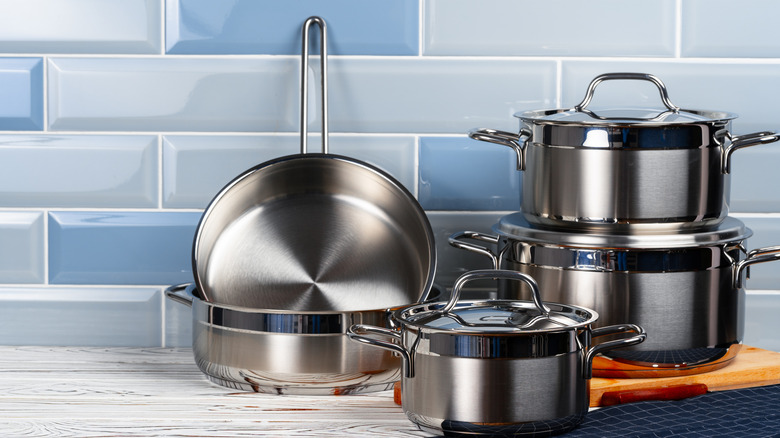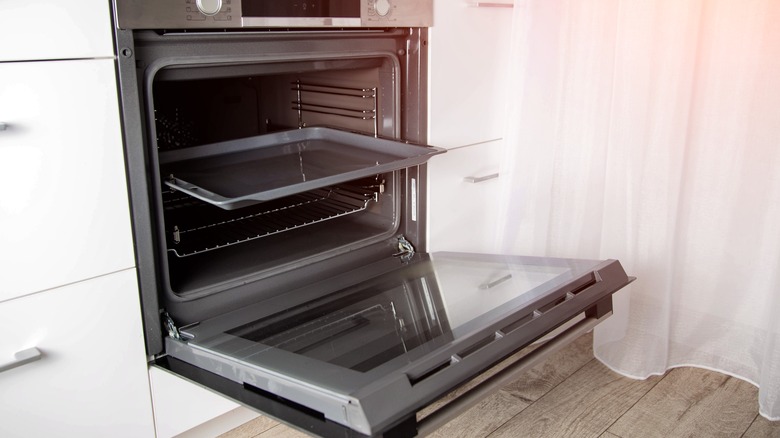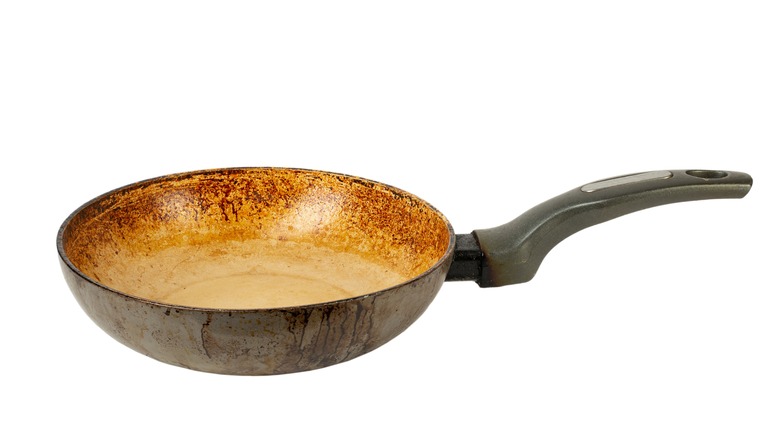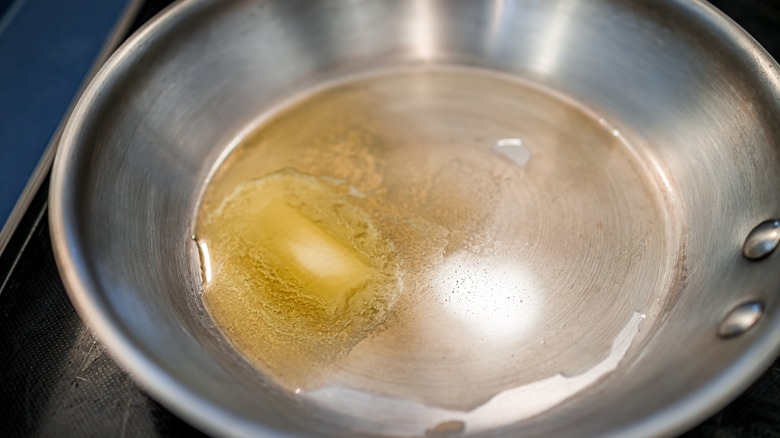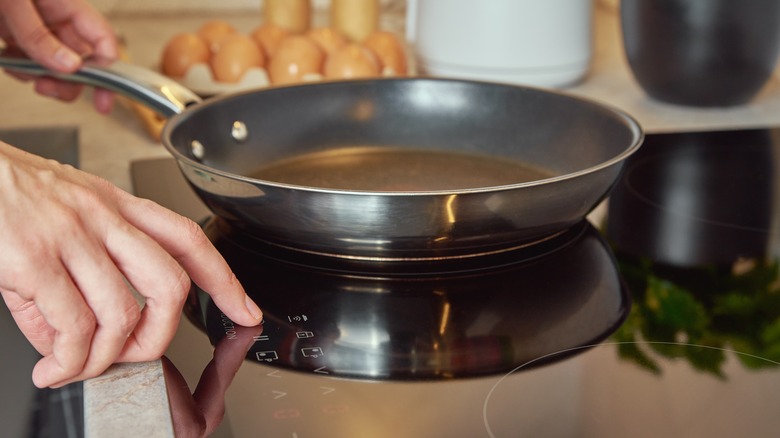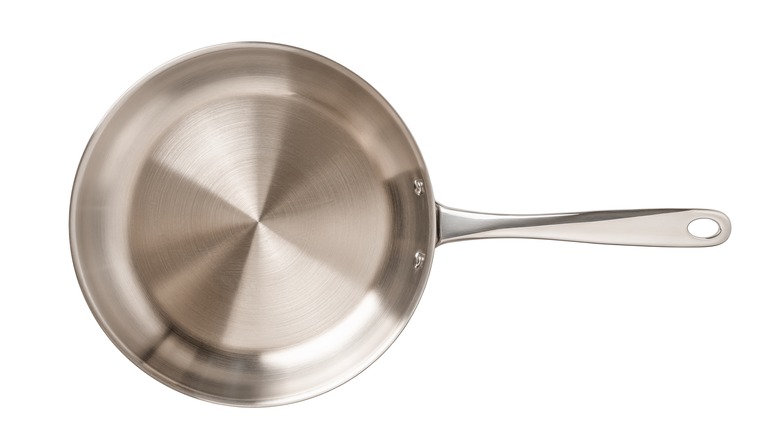11 Tips You Need When Cooking With Stainless Steel
If you want to cook like a real pro, you need stainless steel pans. Sure, nonstick pans are convenient, but there's a reason (actually, a bunch of reasons) why many chefs swear by stainless steel cookware. It's incredibly strong and durable, it heats up evenly and stays hot, and it can be used for an incredibly wide variety of applications. Stainless steel pans are also easy to clean and can even be put in the dishwasher, which is a major bonus.
However, there's a decent chance you've tried out stainless steel pans and had a hard time. They're not necessarily beginner-friendly. If you don't use stainless steel pans correctly, they can have issues with sticking. They also can stain or even rust if they're not treated with care. On the shopping front, it's overwhelming to decide what kind of stainless steel pans to buy since there are so many options. If you're trying to figure out how to cook with stainless steel pans, we're here to help. These tips will allow you to turn out wonderful home-cooked meals with stainless steel pans in no time.
Control heat to prevent sticking
The number one issue that people have with stainless steel pans is that their food sticks to the pan. However, with the right technique, you can cook almost any type of food in stainless steel — even notoriously finicky ingredients like fish or eggs.
One preventive measure is adding oil to your pan to guard against sticking. However, the oil will only work if your pan is at the right temperature. If your pan is too cold when you add the food or if you add too much cold food at once and cool down the pan, the ingredients are much more likely to stick. What you want to happen is for the moisture in the food to evaporate when it hits the pan, creating a cushion of steam that prevents it from sticking. To check if your pan is hot enough, throw a couple of drops of water in the preheated pan before adding oil. The water droplets should slide and bounce around the pan rather than instantly boiling away.
A pan that's too hot is just as bad as one that's too cold. If your pan is excessively hot, your food will just burn, which tastes bad and also causes it to stick.
If meat is stuck to the pan, just wait
Stainless steel will teach you the value of patience as a cook. Even if your pan is perfectly heated, there is a good chance your food will stick to the pan at first, especially if it's a piece of skin-on protein like a salmon filet. If this happens, do not panic and try to scrape your food off of the pan. The sticking is actually the protein's way of telling you it's not ready to flip yet. If your pan is at the right temperature, the food will release from the pan by the time it needs to be flipped, and you'll be rewarded with a gorgeously crispy, golden-brown exterior. You can also reduce the heat under your pan a little bit to encourage the food to unstick itself.
This rule does not apply when you are sautéing vegetables in small pieces. In that case, you actually want to move the veggies around frequently to ensure that they cook evenly.
Stainless steel pans make the best pan sauces
While stainless steel pans' propensity for sticking can be annoying, it's great for some specific cooking situations. When you're planning on making a pan sauce, you actually want little bits of whatever you're cooking to stick to the bottom of the pan and brown. This caramelized layer of food is called fond, and it's the secret to a flavorful pan sauce. If you cook food in a nonstick pan, you won't get any fond because nothing will stick to the pan. Without this crucial element, you'll find that sauces made in nonstick pans tend to taste flat and don't have the depth of flavor of ones made in stainless steel (or cast iron) pans.
To make a pan sauce in a stainless steel pan, simply cook something that produces a fond, like meat or vegetables. De-fat the pan if necessary, then add some kind of cold, flavorful liquid (wine, beer, other alcohol, stock, or vinegar all work), heat that liquid to a boil, and then scrape the fond off of the bottom of the pan (this process is called deglazing). You can add other ingredients or seasonings as you like. Even if you're not planning on making a sauce, you can deglaze a pan with water to remove any stubborn stuck-on brown bits.
One word of caution: browned food tastes great, but burnt food is gross. If your fond burns, it won't make a very tasty sauce.
You can season stainless steel pans
Any fan of cast iron or carbon steel pans knows that seasoning them (that is, building up a coating of polymerized oil on the surface of the pan) is crucial for cooking in these materials without sticking. While seasoning isn't obligatory for stainless steel pans like it is for these other materials, it can be a nice thing to do, especially if you're trying to cook eggs or fish.
First off, you should know that seasoning doesn't work the same for stainless steel as it does for cast iron. Cast iron pans keep their coating permanently, but for stainless steel, seasoning is something you do on a case-by-case basis to temporarily give your pan a non-stick surface right before you cook something. To season a stainless steel pan, heat a small amount of oil in it until the oil smokes. Let the oil cool, then wipe out the pan, leaving a thin coating on the surface of the pan. You can also add salt to help you wipe out the pan.
While you may find seasoning to be helpful, cookware manufacturer Made In advises against seasoning stainless steel. The company argues that seasoning is unnecessary and points out that you have you re-season the pan every time you clean it, as dish soap dissolves the seasoning layer.
Don't use steel wool to clean stainless steel
So you've done it: You invested in a nice set of stainless steel cookware, only to immediately get burnt pieces of food stuck to the bottoms of your pans. You've tried soap, water, and a sponge, but those stubborn stains just won't come off. The natural thing to do at this point is to reach for the steel wool, but that's a bad idea. You want your pans to last as long as possible, and steel wool just isn't the best way to clean stainless steel.
The main problem with steel wool is that it's not gentle enough and can harm your stainless steel pans. For one, it will scratch up the surface, but that's only part of the issue — scrubbing your pans with steel wool can leave them more prone to rusting, which you definitely want to avoid.
Instead of the scouring pad, you should use less abrasive methods to clean stainless steel. For normal cleanup, regular hand-washing should suffice. You can use the deglazing method mentioned above for more stubborn messes. If staining remains, you can boil a baking soda and water solution in the pan. If that still doesn't work, break out the big guns and pick up a can of Bar Keepers Friend cleanser.
Not all stainless steel pans are created equal
Stainless steel pans can be great cooking tools, but if you buy the wrong ones, you'll struggle to achieve the results you want in the kitchen. Low-quality pans may also be less durable than nice ones. Good pans can be a sizable up-front investment, but you'll find over time that it ends up being money well spent.
The most important thing to look for when shopping for pans is what material they're made out of. Although we call them "stainless steel pans," the best ones are actually made of several types of metal sandwiched together. This is called cladding, and it helps to correct for the weaknesses in different metals. For all its virtues in terms of durability and heat retention, stainless steel is simply a poor conductor of heat. By combining it with aluminum, a great conductor, you make up for the deficiencies of the steel. Conversely, steel negates aluminum's greatest weakness: fragility.
More affordable pans are often bottom-clad, which means the sides of the pans are pure stainless steel with no cladding. This is preferable to completely unclad pans, but if you can afford it, spring for fully-clad pans. Check out the design of the handles when you're shopping as well: You want riveted stainless steel handles, as these are the most durable.
Stainless steel is great for stove-to-oven recipes
Let's say one day you've decided to make our recipe for cheddar tarte tatin. You start caramelizing apples in your favorite skillet, then you notice that you're supposed to top the skillet with puff pastry and put it in the oven. There's one big problem: your favorite skillet just so happens to be a nonstick pan with a plastic handle. If you put it in the oven, it's not going to end well, so you have to transfer your ingredients to an oven-safe pan.
Stainless steel pans are perfect tools for recipes like this that start on the stove and move to the oven. Pretty much all stainless steel pans are oven-safe, though there are some things to keep in mind when seeing if your specific pan is suitable for oven use. Per Made In, 18/10, 304, and 400-grade stainless steel alloys will best withstand the heat of the oven. You also want to choose pans with metal handles. Plastic and wood won't work for oven use, and even heat-resistant silicone handles can only get so hot before they melt. Silicone should not be heated past 428 F.
The exact heat tolerance of your pan depends on its construction. Made In claims its pans can handle temperatures up to 800 F, but in general, 500 F is a safer benchmark (your home oven probably can't get anywhere close to 800 F anyway).
Stainless steel isn't entirely rust-proof
Although stainless steel is rust-resistant, it can rust in the right conditions. A little bit of rust can safely be removed with baking soda or Bar Keepers Friend, but you want to make sure your pans never get to the point where they're covered in rust. If your pans get too rusty, they will become unsuitable for cooking and most likely require replacement.
You can guard against rust in a couple of ways. First, and perhaps most importantly, check what type of stainless steel a pan is made with before buying it. Stainless steel is a generic name for many different alloys that combine steel with other types of metal. You want to choose an alloy that contains high levels of chromium, as the chromium guards against rust. Stay away from nickel-free stainless steel, as it is also more rust-prone.
Second, you want to treat your pan the correct way. Don't clean it with abrasive cleaners and minimize its exposure to acid and salt. Salt in particular is dangerous to stainless steel — make sure not to let salt or salty water sit in your pans for too long.
Add oil after you preheat, not before
If you're used to nonstick pans, this is another area where stainless steel differs. You should never preheat an empty nonstick pan because it could easily get too hot, which could damage the nonstick coating or even release toxic gases into the air. Conversely, stainless steel pans should be preheated totally dry and empty. Only add the oil once the pan has come up to temperature.
You should wait to add oil to stainless steel because even though the surface of your pan probably looks mirror-smooth, it's actually covered in tiny holes. If you add oil to a cold stainless steel pan, some of it will get stuck in those pores, reducing its effectiveness in terms of preventing food from sticking and making it more difficult to clean the pan once you're done cooking. If you heat up the pan, the steel actually expands, closing up those microscopic holes.
The benefits of preheating your pan before adding oil don't stop there. You can use less oil this way too. That's because hot oil is runnier than cold oil. A small amount of hot oil will spread over the surface of your pan quite quickly. Adding oil to the pan right before you add the food will also protect the quality of the oil; the less time the oil spends in the pan, the less time it has to degrade from heat exposure.
Not all stainless steel pans work on induction ranges
Induction cooktops may be the way of the future. They're incredibly fuel-efficient because they heat cookware directly rather than heating a burner that then transfers thermal energy to the pan. However, they have one big limitation: Since they work by generating a magnetic field, they're only compatible with pans made from some kind of ferromagnetic metal.
In general, most stainless steel cookware will work on induction stoves. However, not all types of stainless steel are ferromagnetic. Some stainless steel pans made with particularly corrosion-resistant stainless steel alloys are not compatible with induction ranges. If you have an induction stove and are shopping for new stainless steel pans, check with the manufacturer to make sure the pans are induction compatible.
But what if you want to install induction burners in your house and would like to make sure the cookware you already own will work before making the change? Fortunately, there's an easy way to check for induction compatibility. Simply take any magnet and hold it against the bottom of your pan. If the magnet sticks, the pan will work on an induction range.
Avoid thermal shock to keep your pans from warping
One of the major advantages of high-quality stainless steel cookware is its durability. Compared to nonstick pans, good stainless steel pans are much less likely to warp. That doesn't mean it's impossible, though — and you want to avoid warping at all costs because it can be a struggle to cook food evenly on warped pans.
So how do you prevent your stainless steel pans from warping? First, buy good pans. Nicer pans tend to be thicker, which makes them more difficult to warp. Cheap pans made with thin metal will naturally be more prone to warping.
Second, avoid changing the temperature of your pan too quickly. Metal expands when it heats up and contracts as it cools. Furthermore, most stainless steel pans are made from several different types of metal that all expand and contract at different rates. If the metal expands or contracts too fast, that results in something called thermal shock, which can cause your pan to warp. For this reason, you shouldn't heat your pans up too quickly. Perhaps even more importantly, don't cool them down too fast by moving them directly from the stove to a sink full of water or setting them down on a cold counter. You can fix a warped pan by heating it up and then using a mallet to straighten it out, but it's easier to just not warp your pans in the first place.
